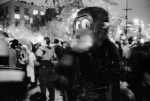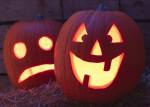 Happy Halloween! Tonight is the night that costumed people go out trick-or-treating while avoiding black cats. Next to the pumpkin pies, Halloween parties, have a bucket which party-goers can dunk their face in for a chance of snagging an apple. Meanwhile, porches all around America are proudly displaying finely carved pumpkins, illuminated by candle light and children stand convinced that monsters and ghosts may, actually, be around every corner. People do all of these things on Halloween because it is tradition (well and because it can also be a lot of fun). We go bobbing for apples and trick-or-treating because our parents went bobbing for apples and trick-or-treating. We dress up in costumes because our grandparents dressed up in costumes. But when did this all start? Was America the first nation to start carving up Jack 0’Lanterns? Continue reading to check out the origin story of five different Halloween traditions.
Happy Halloween! Tonight is the night that costumed people go out trick-or-treating while avoiding black cats. Next to the pumpkin pies, Halloween parties, have a bucket which party-goers can dunk their face in for a chance of snagging an apple. Meanwhile, porches all around America are proudly displaying finely carved pumpkins, illuminated by candle light and children stand convinced that monsters and ghosts may, actually, be around every corner. People do all of these things on Halloween because it is tradition (well and because it can also be a lot of fun). We go bobbing for apples and trick-or-treating because our parents went bobbing for apples and trick-or-treating. We dress up in costumes because our grandparents dressed up in costumes. But when did this all start? Was America the first nation to start carving up Jack 0’Lanterns? Continue reading to check out the origin story of five different Halloween traditions.
 1) Spirits, Demons, and Black Cats… Oh My!
1) Spirits, Demons, and Black Cats… Oh My!
If you read the article, The Origins of Halloween, that we posted earlier in the month, then you know that Halloween started as a Celtic pagan ritual known as Samhain. During this time it was believed that the boundary between the spiritual world and reality was at its thinnest and people could communicate with the dead. This tradition continued when the Church decided that All Saints Day (November 1st) and All Souls Day (November 2nd) would be preceded by All Hallows’ Eve (October 31st) where, like Samhain, the window between the spirit world and our own was thinnest. Likewise, the tradition of avoiding black cats on Halloween, came from the Middle Ages belief that witches avoided detection by changing into a black cat.
 2) Trick-or-Treat … Smell My Feet
2) Trick-or-Treat … Smell My Feet
Trick-or-Treating, in America, is the tradition where children, dressed up in costumes, go door-to-door, collecting candy from households. The ritual goes … child knocks on door … person opens door … child says trick-or-treat … person gives candy. By giving the treat the person avoids the implied threat of a trick. The tradition of trick-or-treating comes from a few places throughout history. In Britain, during the All Souls Day Parade, adults would, originally, go door-to-door asking for food or money and people would give such gifts because it was thought to be a) good luck and b) would keep spirits from doing mischief. Eventually, tradition would start up that the food given was a pastry, nicknamed a “soul cake”. In the Isle-of-Man, another tradition existed that was similar to Trick-or-Treating, called Thump-the-Door Night (Holidays, Festivals, and Celebrations, 1151). On this night, boys would gather outside of the home of a person they did not like and then bombard the household with turnips and cabbage until the person gave money.
Getting oneself all dolled up or dressing up as some sort of monster on Halloween is also not something unique to America. However, unlike our Halloween costumes, these outfits were mainly designed to fend off some evil. During Samhain, the Celtic people would wear animal skins and heads to hide from spirits that meant to do harm. In Britain, people believed that ghosts and spirits could roam the streets on Halloween, but they also believed that the spirits could not come into your house. So if a person decided to leave their house it would behoove them to trick the spirits by dressing up in costume. France added their imprint on dressing up in costume during the 14th and 15th century, by revitalizing a party known as The Danse Macabre. The initial Danse Macabre, started during the plague of Black Death. During this time people would gather together, dressed in costume to hide from the plague. When the party was moved to All Souls Day, people would recreate the Danse because it was believed that demons would be fooled by the masked party-goers.
The Jack o’ Lantern has a couple of origin stories depending on where you look. In Britian, Jack was the name given to the nightwatchmen who walked through the streets with bright lanterns. Eventually, the tradition of carving up pumpkin would begin as a lamp lit to guide dead souls to a food and ale that was placed outside of the household to appease spirits. However, in Ireland, carving up the pumpkin comes from an old tale of a stingy man named Jack. Jack was said to be so cheap that he was barred from heaven. When he then had to go to Hell, he was kicked out because he kept playing practical jokes on the devil. From that point, Jack was condemned to walk the earth with only his lantern until Judgement Day.
During February, the Roman Empire held nine days of commemoration for the dead known as, Parentalia, wherein families would honor and give gifts to the departed (Traditions and Festivals, 94). One of these days was dedicated to the goddess of apples and trees, Pomona. When Rome assimilated Parentalia into the Celtic’s Samhain, the tradition of involving apples into October became common. In America, parties involve a past-time known as bobbing for apples, were guests attempt to extract an apple from a bucket full of water using only their mouth. In Scotland it was believed that young maidens could catch a glimpse of their future husband by eating a apple while looking in a mirror on Halloween (Holidays, Festivals, and Celebrations, 1153). In Wales, families played a game called, Apples and Candles, where families would attach and apple to one end of a stick and a burning candle to another end of the stick, and then suspend the stick from the ceiling. Contestants would have to attempt to eat the apple without using their hands and avoiding being burnt by the candle (Holidays, Festivals, and Celebrations, 0116).



I love this. Thank you for all this information. Wonderful!